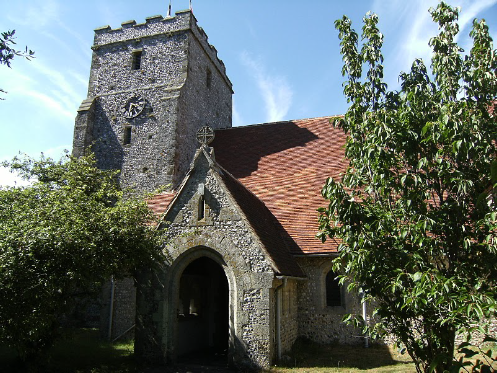



The Parish Church of St George the Martyr, Waterlooville

Winter Edition 2011
Country Churches
127. St Mary the Virgin, Burpham
Just across the river from Arundel Castle lies the small village of Burpham at the end of a winding three mile road which comes to a dead end near the church with only a farm track leading up to the Downs beyond. The church was mentioned in the Domesday Book but only traces of the Saxon foundation remain. The north transept is early 12th century, the tower was added in the 15th century whilst the chancel and south aisle dates from a Victorian restoration in 1869.
As you enter the church via the south porch you will see a biblical text in bold lettering across the top of the north wall of the nave. ‘The Lord is in His Holy Temple: let all the earth keep silence before Him.’ In the north wall are three Victorian glass windows depicting the three Marys -
The large west window (1892) almost hidden behind the organ, is in memory of Robert Drewitt a local farmer. The glass designed by C E Kempe depicts King David and other Old Testament worthies. The nave roof strengthened by four tie beams is of the trussed rafter type. Above the 19th century pulpit is a tablet commemorating William Holmes late Captain of the King’s Own Regiment who died in 1723 aged 50. There is an other interesting military memorial in the north transept relating to 2nd Lt Harold Wanton of the Welsh Regiment who died at Umballa in India in 1903 aged 19. Yet another link to the Empire seen in so many English churches.
An imposing Norman arch with deep undercut moulding, said to represent the Crown of Thorns, marks the entrance to the south transept. There can be seen the two village War Memorials, a memorial window showing the Raising of Jairus’s daughter as well as a painting of the church and churchyard.
The chancel dates from the restoration of 1869 and has an impressive and unusual stone vaulted ceiling. There is a double aumbry in the north wall and a single lancet window above. The east window comprises three single lancets with Victorian glass. On the south side is a leper window dating from 1330. There was a leper colony close by at that time. The low window has three roundels of 12th century German glass depicting St Margaret of Antioch, Abraham entertaining the angels and the Annunciation. The fine balustraded altar rails are Jacobean. Other features in the church include an illustrated list of vicars since 1140 as well as an early 15th century octagonal font with quatrefoils and entwined flowers carved around seven faces.
In the churchyard note the 18th century carved headstone against the west wall of the north transept of Benjamin Brewster. He is portrayed as a jockey on a galloping racehorse. Outside the chancel wall I was astonished to see the grave of the Rev Peter Schneider a former vicar. I knew him well as a College contemporary at Cambridge in the 1950’s.
John Symonds
